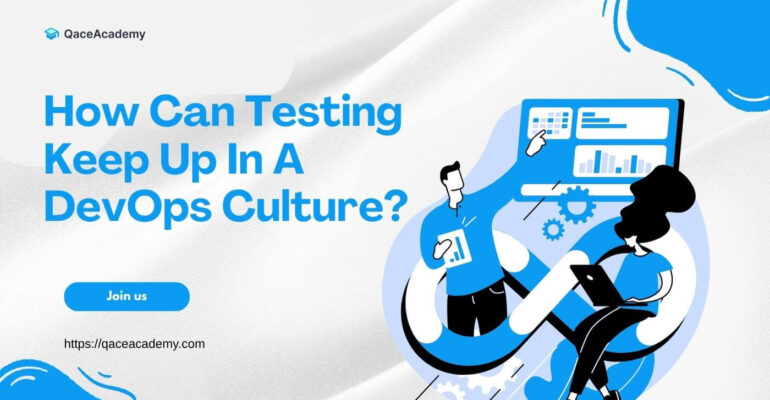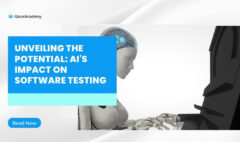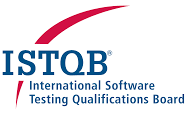How Can Testing Keep Up In A DevOps Culture?
How Can Testing Keep Up In A DevOps Culture?
Outline
- Introduction
- Overview of DevOps culture
- Importance of testing in DevOps
- Evolution of Testing in DevOps
- Traditional testing vs. DevOps testing
- Challenges in integrating testing in DevOps
- Principles of Testing in DevOps
- Shift-left testing approach
- Continuous testing practices
- Automation and infrastructure as code
- Strategies for Effective Testing in DevOps
- Implementing test automation pipelines
- Leveraging containerization for testing
- Incorporating monitoring and feedback loops
- Overcoming Common Testing Bottlenecks
- Addressing cultural resistance to change
- Ensuring collaboration between development and operations teams
- Managing test environments efficiently
- Tools and Technologies for DevOps Testing
- Continuous integration (CI) tools
- Test automation frameworks
- Container orchestration platforms
- Case Studies and Best Practices
- Success stories of organizations implementing DevOps testing
- Lessons learned and key takeaways
- Future Trends and Considerations
- Emerging technologies shaping the future of DevOps testing
- Predictions for the evolution of testing practices in DevOps
- Conclusion
- Recap of key points
- Final thoughts on the role of testing in a DevOps culture
Introduction
In recent years, the DevOps culture has revolutionized the way software is developed, deployed, and maintained. DevOps, a portmanteau of “development” and “operations,” emphasizes collaboration, automation, and integration between software development teams and IT operations.
This cultural shift aims to streamline the software delivery process, enabling organizations to release high-quality applications at a faster pace and with greater efficiency.
Central to the DevOps philosophy is the concept of continuous integration, and continuous delivery (CI/CD), which advocates for frequent and incremental code changes, automated testing, and rapid deployment.
While DevOps offers numerous benefits, including shorter development cycles, improved product quality, and increased customer satisfaction, it also presents unique challenges for traditional software testing practices.
Historically, software testing has been a distinct phase in the development lifecycle, typically occurring after code has been written and before deployment. However, in a DevOps culture, testing must be integrated seamlessly throughout the entire software delivery pipeline, from code commit to production release.
This shift requires a fundamental reevaluation of testing methodologies, tools, and processes to ensure they align with the principles of DevOps.
This article explores the evolving role of testing in a DevOps culture and examines strategies for effectively integrating testing into CI/CD workflows.
By adopting a holistic approach to testing, organizations can achieve the twin goals of accelerated delivery and enhanced product quality in the dynamic and fast-paced world of DevOps.
Evolution of Testing in DevOps
The evolution of testing practices in DevOps represents a departure from traditional methodologies and a shift towards a more collaborative and automated approach.
In traditional software development models, testing often occurs as a separate phase, isolated from other stages of the development lifecycle. This sequential approach can lead to bottlenecks, delays, and a lack of feedback loops between developers and testers.
In contrast, DevOps advocates for the integration of testing throughout the entire software delivery pipeline, from development to production.
This shift, often referred to as “shift-left” testing, emphasizes early and continuous testing, with the goal of detecting and addressing defects as soon as possible in the development process.
By moving testing closer to the source code and leveraging automation tools, organizations can identify issues earlier, reduce rework, and accelerate the delivery of high-quality software.
However, integrating testing into a DevOps culture is not without its challenges. Legacy testing tools and processes may not be well-suited to the rapid pace and automation-driven nature of DevOps workflows.
Additionally, cultural barriers between development and operations teams can hinder collaboration and communication, leading to friction and inefficiencies.
Principles of Testing in DevOps
Testing in a DevOps culture is guided by several key principles that emphasize collaboration, automation, and continuous improvement. These principles are essential for ensuring the effectiveness and efficiency of testing practices in a fast-paced and dynamic environment.
Shift-left testing approach: DevOps promotes the concept of “shift-left” testing, which involves moving testing activities earlier in the software development lifecycle.
By shifting testing closer to the beginning of the development process, teams can identify and address defects sooner, reducing the cost and effort required to fix them later. This approach fosters a culture of quality ownership among developers and encourages proactive problem-solving throughout the development cycle.
Continuous testing practices: Continuous testing is integral to the DevOps philosophy, enabling teams to validate code changes rapidly and reliably. Unlike traditional testing, which occurs as a separate phase, continuous testing involves running automated tests continuously throughout the CI/CD pipeline.
This approach provides immediate feedback on the quality of code, allowing teams to detect and address issues in real-time. Continuous testing also facilitates faster release cycles and promotes a “fail-fast” mentality, where defects are identified and resolved quickly to minimize impact on users.
Automation and infrastructure as code: Automation is a cornerstone of DevOps testing, enabling teams to streamline repetitive tasks and accelerate the delivery of software. Through automation, tests can be executed more efficiently and consistently, reducing manual effort and human error.
In addition to test automation, DevOps encourages the use of infrastructure as code (IaC) to provision and manage testing environments programmatically. By treating infrastructure configuration as code, teams can ensure consistency, repeatability, and scalability across their testing environments, leading to more reliable and predictable results.
These principles provide a framework for integrating testing into DevOps workflows effectively. By embracing shift-left testing, continuous testing practices, and automation, organizations can optimize their testing efforts and deliver high-quality software at speed.
Strategies for Effective Testing in DevOps
Implementing test automation pipelines: Test automation pipelines are a fundamental component of DevOps testing strategies. These pipelines automate the execution of tests at various stages of the CI/CD process, from code commit to production deployment.
By integrating automated tests into the pipeline, teams can quickly validate code changes and identify regressions, ensuring that only high-quality code is promoted to production. Test automation pipelines also facilitate faster feedback loops, enabling teams to iterate rapidly and deliver software with confidence.
Leveraging containerization for testing: Containerization technologies, such as Docker and Kubernetes, play a crucial role in DevOps testing by providing lightweight, portable, and scalable environments for running tests. Containers encapsulate applications and their dependencies, making it easy to create isolated testing environments that closely resemble production.
By containerizing tests, teams can ensure consistency across different environments, optimize resource utilization, and accelerate the provisioning of testing infrastructure. Container orchestration platforms, such as Kubernetes, further enhance testing scalability and resilience by automating the deployment and management of containerized test environments.
Incorporating monitoring and feedback loops: Monitoring and feedback loops are essential for continuously assessing the performance and reliability of software in production. DevOps teams leverage monitoring tools and techniques to collect metrics, logs, and other telemetry data from live systems, enabling them to detect anomalies, identify bottlenecks, and troubleshoot issues in real-time.
By incorporating monitoring into the testing process, teams can gain valuable insights into the behavior of their applications under different conditions, helping them improve resilience, scalability, and user experience.
Feedback loops between development, operations, and testing teams ensure that insights from monitoring are used to inform future development and testing efforts, driving continuous improvement and innovation.
These strategies empower DevOps teams to overcome common testing challenges and deliver high-quality software with speed, efficiency, and confidence.
By implementing test automation pipelines, leveraging containerization for testing, and incorporating monitoring and feedback loops, organizations can streamline their testing processes and achieve greater agility, reliability, and customer satisfaction.
Overcoming Common Testing Bottlenecks in a DevOps culture
Addressing cultural resistance to change: One of the primary challenges in implementing testing in a DevOps culture is overcoming cultural resistance to change. Traditional development and operations teams may be accustomed to siloed working environments and may resist collaborative approaches.
To address this challenge, organizations must foster a culture of collaboration, transparency, and continuous learning. Encouraging open communication, sharing successes and failures, and providing training and support for new tools and methodologies can help break down cultural barriers and facilitate the adoption of DevOps testing practices.
Ensuring collaboration between development and operations teams: Collaboration between development and operations teams is essential for successful DevOps testing. However, achieving effective collaboration requires more than just breaking down silos—it requires building trust, fostering mutual respect, and aligning goals and incentives.
Cross-functional teams, shared responsibilities, and joint accountability can help bridge the gap between development and operations, enabling teams to work together seamlessly towards common objectives.
Additionally, leveraging collaboration tools and platforms, such as chat channels and issue trackers, can facilitate communication and coordination between teams, ensuring that everyone is aligned and informed throughout the testing process.
Managing test environments efficiently: Managing test environments efficiently is another common bottleneck in DevOps testing. Traditional testing environments are often complex, resource-intensive, and difficult to provision and manage.
To overcome this challenge, organizations can leverage infrastructure as code (IaC) and cloud computing technologies to automate the provisioning and configuration of test environments. By defining infrastructure requirements in code and using cloud-based services for dynamic provisioning, teams can create and tear down test environments on-demand, reducing lead times and resource wastage.
Additionally, containerization technologies, such as Docker, provide lightweight and portable alternatives to traditional virtual machines, enabling teams to create consistent and reproducible test environments across different platforms and configurations.
By addressing these common testing bottlenecks, organizations can streamline their testing processes, accelerate delivery cycles, and improve the quality and reliability of their software.
By embracing cultural change, fostering collaboration between development and operations teams, and leveraging automation and cloud technologies, organizations can overcome the challenges of testing in a DevOps culture and realize the full benefits of continuous integration, continuous testing, and continuous delivery.
Tools and Technologies for DevOps Testing
Continuous integration (CI) tools: CI tools automate the process of integrating code changes from multiple developers into a shared repository, facilitating early detection of integration errors and ensuring code quality. Popular CI tools, such as Jenkins, Travis CI, and CircleCI, enable teams to automate build, test, and deployment processes, providing visibility into the status of code changes and facilitating collaboration among team members. These tools also support integration with version control systems, issue trackers, and other development tools, allowing for seamless integration into existing workflows.
Test automation frameworks: Test automation frameworks provide a structured approach to creating and executing automated tests, enabling teams to validate software functionality quickly and reliably.
There are various test automation frameworks available for different programming languages and application types, including Selenium WebDriver for web applications, Appium for mobile applications, and JUnit for Java applications.
These frameworks offer features such as assertion libraries, test data management, and reporting capabilities, empowering teams to build robust and maintainable test suites that cover a wide range of test scenarios.
Container orchestration platforms: Container orchestration platforms, such as Kubernetes, provide automated management and scaling of containerized applications, simplifying the deployment and operation of complex distributed systems.
Kubernetes orchestrates the deployment, scaling, and management of containerized workloads across a cluster of machines, ensuring high availability, resource utilization, and fault tolerance.
By containerizing tests and leveraging Kubernetes for orchestration, teams can create scalable and reproducible testing environments that closely resemble production, enabling them to test applications in realistic scenarios and identify issues early in the development process.
These tools and technologies play a critical role in enabling DevOps teams to implement effective testing practices and deliver high-quality software at speed.
By leveraging CI tools for automating build and test processes, test automation frameworks for creating and executing automated tests, and container orchestration platforms for managing testing environments, organizations can streamline their testing workflows, accelerate delivery cycles, and improve the reliability and resilience of their applications.
Case Studies and Best Practices
Case studies offer valuable insights into how organizations have successfully implemented DevOps testing practices and overcome common challenges. By examining real-world examples, teams can learn from others’ experiences and gain practical strategies for improving their own testing processes. Here are a few case studies and best practices:
Netflix: Netflix is renowned for its sophisticated DevOps practices, including testing. The streaming giant utilizes a comprehensive suite of automated tests to ensure the reliability and performance of its platform.
By leveraging continuous integration and deployment pipelines, Netflix can rapidly deploy changes to its infrastructure and applications while maintaining high levels of quality and availability. Their approach emphasizes automated testing at scale, enabling them to detect and resolve issues quickly and efficiently.
Etsy: Etsy, an online marketplace for handmade and vintage goods, has embraced a culture of experimentation and continuous improvement. The company employs a variety of testing techniques, including A/B testing, canary deployments, and chaos engineering, to validate changes and mitigate risks.
By incorporating testing into their deployment process, Etsy can safely release new features and updates to millions of users worldwide without impacting performance or reliability.
Amazon: Amazon, one of the pioneers of DevOps, relies heavily on automation and monitoring to maintain the reliability of its e-commerce platform. The company employs a sophisticated testing infrastructure, including thousands of automated tests running in parallel, to validate changes across its vast and complex system.
By investing in automation and infrastructure as code, Amazon can quickly deploy changes to production while minimizing the risk of downtime or disruption to customers.
Future Trends and Considerations
As DevOps continues to evolve, several trends and considerations are shaping the future of testing in DevOps culture:
Shift-right testing: While shift-left testing focuses on identifying defects early in the development process, shift-right testing emphasizes testing in production and collecting feedback from real users.
By monitoring production environments and analyzing user behavior, teams can uncover issues that may not have been detected during earlier stages of testing. Shift-right testing enables organizations to deliver more customer-centric solutions and improve the overall user experience.
AI and machine learning: Artificial intelligence (AI) and machine learning (ML) technologies are increasingly being integrated into testing tools and platforms, enabling teams to automate repetitive tasks, analyze large volumes of data, and make data-driven decisions.
AI-powered testing solutions can enhance test coverage, identify patterns and anomalies, and predict potential issues before they occur. By harnessing the power of AI and ML, organizations can streamline their testing processes and deliver more reliable software with greater efficiency.
DevSecOps: DevSecOps extends the principles of DevOps to include security considerations throughout the software development lifecycle. Security testing, including vulnerability scanning, penetration testing, and code analysis, is integrated seamlessly into the CI/CD pipeline, enabling teams to identify and remediate security issues early in the development process.
By incorporating security into DevOps workflows, organizations can minimize security risks, protect sensitive data, and build trust with their customers.
Serverless architecture: Serverless architecture, which abstracts server management and infrastructure provisioning away from developers, presents new challenges and opportunities for testing in DevOps. With serverless computing, developers can focus on writing code without worrying about underlying infrastructure, leading to faster development cycles and more scalable applications.
However, testing serverless applications requires new approaches and tools, as traditional testing methodologies may not be applicable in a serverless environment. Organizations must adapt their testing strategies to account for the unique characteristics of serverless architecture, including event-driven workflows, stateless functions, and third-party dependencies.
Hybrid cloud environments: As organizations increasingly adopt hybrid cloud environments, consisting of a mix of on-premises and cloud-based infrastructure, testing across heterogeneous environments becomes more complex. Testing in hybrid cloud environments requires careful coordination and orchestration to ensure consistent behavior across different platforms and configurations.
Organizations must invest in tools and technologies that support testing in hybrid cloud environments, such as multi-cloud orchestration platforms, cross-platform testing frameworks, and hybrid cloud testing strategies.
Future Trends and Considerations
As DevOps culture continues to mature, several emerging trends and considerations are shaping the future of testing:
Shift-Down Testing: While traditional testing focuses on verifying functionality, shift-down testing emphasizes testing from the user’s perspective. This approach involves gathering feedback from end-users early in the development process through techniques such as user acceptance testing (UAT), beta testing, and usability testing.
By incorporating user feedback into the testing process, teams can ensure that software meets user expectations and delivers a positive user experience.
DataOps: DataOps extends DevOps principles to data management and analytics, emphasizing collaboration, automation, and continuous improvement in data-related processes. Testing in DataOps involves validating data quality, integrity, and consistency across various sources and pipelines.
By implementing automated data testing frameworks and leveraging data virtualization and masking techniques, organizations can ensure the accuracy and reliability of their data-driven applications.
Chaos Engineering: Chaos engineering is a discipline that involves deliberately injecting failures and disturbances into systems to proactively identify weaknesses and vulnerabilities.
By simulating real-world scenarios, such as network outages, server failures, and traffic spikes, chaos engineering enables teams to assess system resilience and recoverability. Testing in chaos engineering involves designing and executing experiments to validate system behavior under adverse conditions, helping teams build more robust and resilient architectures.
Compliance as Code: Compliance as code integrates regulatory compliance requirements into infrastructure and application code, enabling organizations to automate compliance validation and enforcement.
Testing in compliance as code involves verifying that infrastructure configurations and application deployments adhere to regulatory standards and best practices. By implementing automated compliance testing frameworks and leveraging infrastructure as code (IaC) tools, organizations can ensure continuous compliance and reduce the risk of security breaches and audit failures.
Quantum Computing Testing: Quantum computing represents a paradigm shift in computing technology, with the potential to revolutionize fields such as cryptography, optimization, and machine learning.
Testing in quantum computing involves verifying the correctness and performance of quantum algorithms and hardware components. As quantum computing becomes more accessible, organizations will need to develop specialized testing methodologies and tools to validate quantum applications and systems.
In conclusion, the exploration of testing within a DevOps culture reveals a dynamic landscape marked by continuous evolution, innovation, and adaptation.
As organizations embrace the principles of DevOps, including collaboration, automation, and continuous improvement, testing practices are undergoing fundamental shifts to meet the demands of modern software development.
The evolution of testing in DevOps is characterized by a departure from traditional methodologies towards a more holistic and integrated approach. Shift-left testing emphasizes early and continuous testing, while automation and infrastructure as code enable teams to streamline testing processes and accelerate delivery cycles.
Collaboration between development and operations teams is paramount, fostering a culture of shared responsibility and accountability.
Despite these advancements, organizations face common challenges in implementing testing in a DevOps culture, including cultural resistance to change, collaboration barriers, and inefficient test environment management. However, through cultural transformation, effective collaboration, and leveraging automation and cloud technologies, these challenges can be overcome, enabling organizations to realize the full benefits of DevOps testing.
Looking towards the future, emerging trends such as shift-down testing, DataOps, chaos engineering, compliance as code, and quantum computing testing are reshaping the testing landscape, offering new opportunities for innovation and improvement.
By embracing these trends and integrating them into their testing practices, organizations can stay ahead of the curve and deliver high-quality software that meets the demands of today’s rapidly evolving technology landscape.
In essence, testing in a DevOps culture is not just about detecting defects—it’s about fostering a culture of quality, collaboration, and continuous improvement.
By embracing DevOps principles and leveraging cutting-edge technologies and methodologies, organizations can transform their testing processes, accelerate delivery cycles, and deliver software that exceeds customer expectations in today’s fast-paced and ever-changing digital world.











